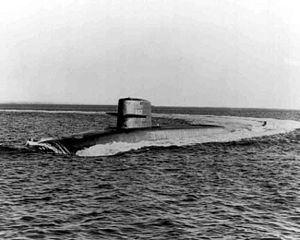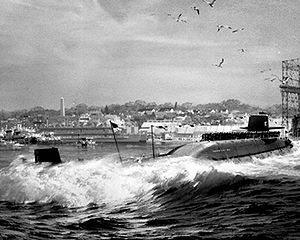USS Francis Scott Key
 USS Francis Scott Key (SSBN-657) commencing a hard turn to starboard, possibly during her sea trials off the United States East Coast sometime before December 1966.
| |
| History | |
|---|---|
| Namesake | Francis Scott Key (1779–1843), author of the words to the United States' national anthem, "The Star-Spangled Banner" |
| Ordered | 29 July 1963 |
| Builder | General Dynamics Electric Boat, Groton, Connecticut |
| Laid down | 5 December 1964 |
| Launched | 23 April 1965 |
| Sponsored by | Mrs. Marjory Key Thorne and Mrs. William T. Jarvis |
| Commissioned | 3 December 1966 |
| Decommissioned | 2 September 1993 |
| Stricken | 2 September 1993 |
| Fate | Scrapping via Ship and Submarine Recycling Program completed 1 September 1995 |
| General characteristics | |
| Class and type | Benjamin Franklin-class fleet ballistic missile submarine |
| Displacement |
|
| Length | 425 ft (130 m) |
| Beam | 33 ft (10 m) |
| Draft | 31 ft (9.4 m) |
| Installed power | 15,000 shp (11,185 kW) |
| Propulsion | One S5W pressurized-water nuclear reactor, two geared steam turbines, one shaft |
| Speed | Over 20 knots |
| Test depth | 1,300 feet (400 m) |
| Complement | Two crews (Blue Crew and Gold Crew) of 120 men each |
| Armament |
|
USS Francis Scott Key (SSBN-657), a Benjamin Franklin-class ballistic missile submarine, was the only submarine of the United States Navy to be named for Francis Scott Key (1779–1843), an American lawyer, author, and amateur poet who wrote the poem "The Defense of Fort McHenry", which became the words to the United States' national anthem, "The Star-Spangled Banner". During World War II there was a liberty ship named SS Francis Scott Key.
Construction and commissioning

The contract to build Francis Scott Key was awarded to the Electric Boat Division of General Dynamics Corporation in Groton, Connecticut on 29 July 1963 and her keel was laid down there on 5 December 1964. She was launched on 23 April 1965, sponsored by Mrs. Marjory Key Thorne and Mrs. William T. Jarvis, both direct descendants of Key,[1] and commissioned on 3 December 1966, with Captain Frank W. Graham in command of the Blue Crew and Lieutenant Commander Joseph B. Logan in command of the Gold Crew.
Service history
The Francis Scott Key was part of Submarine Squadron (SUBRON) 16 based in Rota, Spain. The squadron and submarines moved to Kings Bay, Georgia in 1979.
The Key conducted the first submerged launch of a Trident missile in 1979. She also became the first submarine to go on deterrent patrol with Trident I missiles.
The Gold crew performed the submarine's last SSBN deterrent patrol, Patrol #72, in 1992. The Key combined crews and changed homeport from Charleston, SC to Pearl Harbor, HI in late 1992.

Decommissioning and disposal
Francis Scott Key was decommissioned on 2 September 1993 with Commander Carl D. Olson in command, and stricken from the Naval Vessel Register the same day. Her scrapping via the U.S. Navy's Nuclear-Powered Ship and Submarine Recycling Program at Bremerton, Washington, was completed on 1 September 1995.
References
- ^ "Polaris Sub's Deterrent Role Cited at Launching". General Dynamics News – Electric Boat Edition. May 1966. Retrieved 11 November 2022.
Mrs. William T. Jarvis and Mrs. Marjory Key Thorne, both direct descendants of Key, christened the divisions's 16th missile firing sub. About 65 other descendants attended the ceremony
 This article includes information collected from the Naval Vessel Register, which, as a U.S. government publication, is in the public domain. The entry can be found here.
This article includes information collected from the Naval Vessel Register, which, as a U.S. government publication, is in the public domain. The entry can be found here.- Photo gallery of USS Francis Scott Key at NavSource Naval History
External links
- "SSBN 657 USS Francis Scott Key Crew Home Page". Retrieved 26 September 2011.
- "USS Francis Scott Key Navy Unit Commendation September 1978 – October 1979". Retrieved 14 March 2016.
